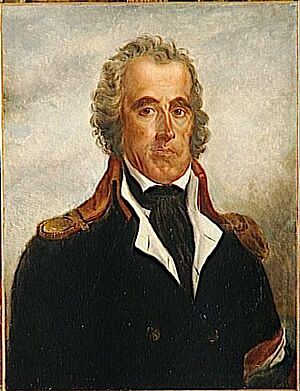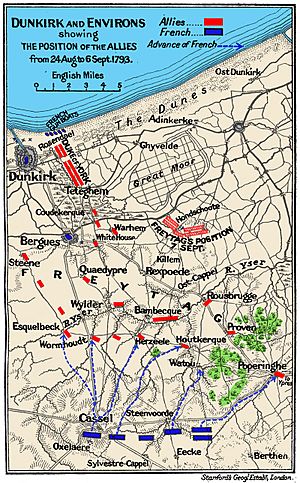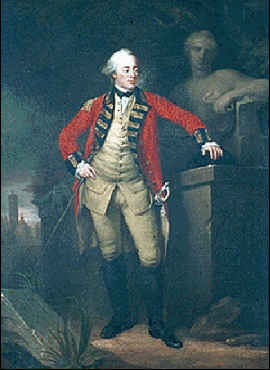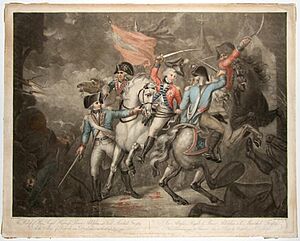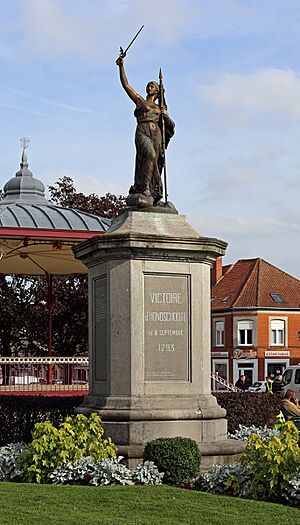Battle of Hondschoote facts for kids
Quick facts for kids Battle of Hondschoote |
|||||||
|---|---|---|---|---|---|---|---|
| Part of the Flanders campaign in the War of the First Coalition | |||||||
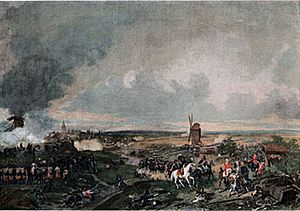 The Battle of Hondschoote |
|||||||
|
|||||||
| Belligerents | |||||||
| Commanders and leaders | |||||||
| Strength | |||||||
| 40,000 | 24,000 | ||||||
| Casualties and losses | |||||||
| 3,000 killed, wounded or captured | 4,000 killed, wounded or captured | ||||||
The Battle of Hondschoote was a key fight during the French Revolutionary Wars. It happened in September 1793 as part of the Flanders Campaign. This battle took place near Hondschoote, France. French forces, led by Generals Jean Nicolas Houchard and Jean-Baptiste Jourdan, fought against British and Hanoverian troops. These enemy forces were commanded by the Duke of York and Marshal Freytag. The battle ended with a victory for the French army.
Contents
Why Did the Battle of Hondschoote Happen?
The War of the First Coalition Begins
By August 1793, a group of countries called the Coalition Army was fighting France. This army included Austria, Britain, and Hanover. They had already captured several French towns. The Coalition planned to attack Cambrai next.
The Plan to Capture Dunkirk
However, the British government had a different idea. They wanted their troops, led by the Duke of York, to capture Dunkirk. Dunkirk was a port city on the coast. The British thought it would be a very useful military base. They believed Dunkirk's defenses were weak.
Setting Up the Siege of Dunkirk
The Duke of York gathered his forces. He split his army into two parts. About 22,000 British soldiers went to surround Dunkirk. Another 14,500 Hanoverian troops, led by Marshal Freytag, protected the main army's side. The Duke of York pushed the French defenders back into Dunkirk. He started to besiege the city from the east. But the siege was difficult because York did not have enough heavy cannons or soldiers to fully surround Dunkirk.
Freytag's Spread-Out Army
Meanwhile, Marshal Freytag's troops advanced. They pushed French forces back to Bergues, a fortified town. Freytag's army then spread out in a long, thin line. This line had many small outposts in different villages. Freytag was an experienced commander. But his strategy of spreading out his troops would cause problems later.
The New French Commander
The French army in the north, called the Armée du Nord, got a new commander. His name was Jean Nicolas Houchard. He was a brave general. But he was not used to leading such a large army. France was going through a difficult time called the Reign of Terror. Generals who failed could be arrested. This made Houchard very worried and unsure.
French Reinforcements Arrive
Despite Houchard's worries, the French army was growing stronger. Many new soldiers were joining. Lazare Carnot, a powerful leader, ordered more troops to gather south of Freytag's position. By late August, the French had tens of thousands of soldiers ready.
Allies Ask for Help
The British and Hanoverians knew the French were getting stronger. They asked for more soldiers from their allies. But the Austrian army was busy with another siege. So, only a few more troops were sent to help.
French Attacks Before the Main Battle
On August 27, Houchard sent 15,000 French soldiers to attack. They aimed for towns like Tourcoing and Menin. The French had some early success. But then their soldiers started to scatter and plunder. This caused confusion. Houchard lost some cannons and missed a chance to cut off the British army.
The Battle of Hondschoote: September 6–8, 1793
French Plans and Forces
Houchard realized the Duke of York wanted to capture Dunkirk. He saw a chance to attack the enemy forces. His first idea was to make a small attack to draw York away. But French political leaders pressured him. They wanted a direct attack on Freytag's spread-out line.
By September 5, Houchard had about 45,800 soldiers. Freytag, worried about the French build-up, sent troops to capture a village. But the French were ready to attack.
French Attack on September 6
On September 6, about 30,000 French soldiers attacked. They moved in several groups. One group, led by Hédouville, pushed enemy defenders back. Another group, led by Vandamme, advanced easily. But on the left side, French troops faced strong resistance.
In the middle, Colaud's group pushed defenders from a village. Houchard and Jourdan joined them. Jourdan led an attack that quickly captured another town. The fighting was tough. The Hanoverian soldiers fought bravely, even though they were outnumbered. A heavy rainstorm made things harder.
French ammunition started to run low. Jourdan asked if they should stop. But the chief of staff said they must win at any cost. He told them to use bayonets if they ran out of bullets. Finally, French soldiers managed to cross a river. The Hanoverians had to retreat.
Freytag's Capture and Retreat
At 8:00 PM, Freytag ordered his troops to retreat to Hondschoote. He didn't know that the French had already taken a town on his route. Freytag's column walked right into French outposts. There was a confused fight. Freytag was wounded and captured. The Duke of Cambridge, who was with him, also got captured but quickly escaped.
Freytag remained a prisoner for a short time. Then, Wallmoden, another Hanoverian commander, arrived. He retook the town and freed Freytag. The French soldiers were so surprised that some ran all the way back to Cassel. Wallmoden then took command and led his troops to Hondschoote. He set up a strong defense there. He asked the Duke of York for more soldiers.
French Reorganize for September 8 Attack
On September 7, Houchard tried to attack again. But Jourdan's troops were tired and disorganized. So, Houchard pulled them back to reorganize. Meanwhile, other French groups advanced. By the morning of September 8, Wallmoden had 13,000 men at Hondschoote. He faced three fresh French groups totaling 17,800 soldiers. Behind them were more French troops.
The Final Attack on Hondschoote
Houchard decided to attack Hondschoote from three sides. On the left, Leclaire's group attacked along a canal. In the center, Houchard personally led the main attack with Jourdan's soldiers. They marched directly along a raised path, supported by cannons. Vandamme's and Colaud's groups also attacked from the sides.
Houchard sent other troops to different places. Some went to help pin down the Duke of York at Dunkirk. Others were left far from the main battle. This meant Houchard only used about 22,000 of his 43,000 men for the main attack. This spreading out of forces was a mistake.
The battle was very intense. The ground around Hondschoote had many hedges and ditches. This was good for the French, who used many skirmishers (soldiers who fight in small, spread-out groups). They fired constantly from behind cover. After four hours of fighting, the French in the center were struggling. They were slowly being pushed back.
Houchard rode to bring up more troops. Jourdan, though slightly wounded, brought forward his last reserve soldiers. Finally, Houchard gave the signal to attack again. Houchard himself led a cavalry charge.
Hanoverian Retreat
The Hanoverian troops had lost many men. Their left side was seriously threatened. They were also running out of ammunition. So, they were finally forced out of Hondschoote. Wallmoden's troops, who had fought bravely, retreated in two groups. They were covered by other soldiers and cavalry, which stopped the French from chasing them.
What Happened After the Battle?
The Duke of York Retreats
When the Duke of York heard that his left side was exposed, he decided to end the siege of Dunkirk. The French had made the canal unusable for transport. So, the Duke of York had to leave behind his heavy siege cannons. On the night of September 8, York's army began to retreat to the coastal city of Furnes (now Veurne in Belgium). There, he met up with Wallmoden's remaining troops.
Houchard did not chase York's army. This allowed York to escape without further fighting. Part of the reason was that the French army was very disorganized after the battle. Some French troops were sent to pursue, but they stopped when they reached a broken bridge or marshy ground.
Casualties and Outcome
Wallmoden's forces lost about 2,331 soldiers out of 9,000 infantry. This included a general who was captured and later died. The French losses were similar, around 1,800 soldiers.
At Hondschoote, about 30,000 French soldiers defeated 14,500 Hessian and Hanoverian soldiers. The French captured six flags and 32 of the Duke of York's cannons.
Houchard's Fate
Despite this important victory, the French political leaders were not happy with Houchard. They saw his hesitations during the battle. He also refused to chase York's army, saying his men were too tired. This decision proved fatal for him. Houchard was later arrested for cowardice. He was tried and executed by guillotine.
Why Was This Battle Important?
Historians have studied the Battle of Hondschoote closely. Some, like Alfred Burne, point out that the Duke of York blamed Marshal Freytag for the problems. York believed Freytag did not react quickly enough to reports of the enemy's attack.
Burne also disagreed with other historians about Freytag's initial position. He argued that Freytag's chosen position was actually the best. His mistake was forgetting his main goal: to protect the army besieging Dunkirk. The battle showed the challenges of commanding large armies during this time.
Images for kids


